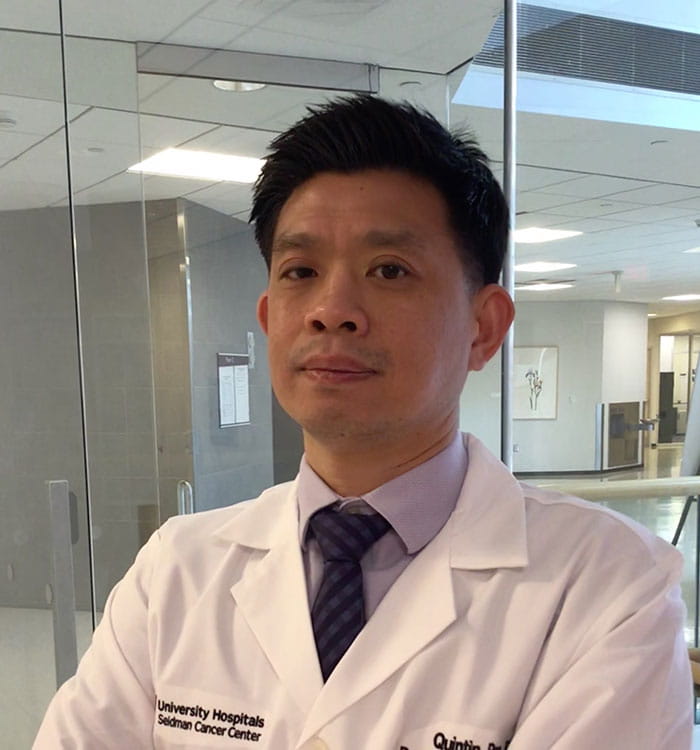Understanding Racial Disparities in Head and Neck Cancer
November 09, 2020
Study from UH Seidman Cancer Center suggests biological differences in tumors between African-Americans and European-Americans driving differences in outcomes
Innovations in Cancer | Fall 2020
Racial disparities in outcomes for patients with oral cavity squamous cell carcinoma (OCSCC) have traditionally been thought to have their roots in differences in access to healthcare and other social determinants of health. However, according to new research from UH Seidman Cancer Center, that’s not the complete picture.
 Quintin Pan, PhD
Quintin Pan, PhDIn a study of OCSCC patients treated at UH Seidman Cancer Center between 2010 and 2017, researchers found no differences in time to treatment initiation between African-American patients and European-American patients. At the same time, however, they found that African-American patients had significantly higher mutational loads in their tumors when compared with European-Americans, suggesting biological factors play more of a role in outcome than previously believed. This work was published in the journal JCO Oncology Practice.
“It does not appear that access to medical care is an issue for the patients in our system, which is fantastic news,” says Quintin Pan, PhD, Deputy Director of Research at UH Seidman Cancer Center and Professor of Otolaryngology Case Western Reserve University School of Medicine. “But with that said, there is still a difference in survival. We’re trying to dissect out and identify biological factors that are driving this survival difference. The unanswered key question in the field is whether biological factors are driving the difference in outcome. That was really the impetus for our project.”
For the study, the UH Seidman Cancer Center research team performed a retrospective chart review of OCSCC patients treated between Jan.1, 2010 and Dec. 31, 2017, stratified by race. The team collected data on and analyzed differences in patient age, sex, TNM stage and time to treatment initiation and tumor pathologic characteristics. In addition, the team examined the genetic profiles of OCSCC using The Cancer Genome Atlas (TCGA), identifying a number of candidate genes with high probability of being differentially regulated in African-Americans with OCSCC.
Results showed no differences in time to treatment initiation between African-Americans and European-Americans, for both T1/T2 tumors and more advanced T3/T4 tumors. African-American patients did present with a greater proportion of T3/T4 disease, compared with their European-American counterparts. However, Dr. Pan says this more advanced burden of disease at presentation could not explain the differences in survival seen between African-American and European-American patients.
“African-Americans tended to present in our clinic with advanced disease,” he says. “But even after controlling for that, there was still a survival difference.”
“Our data suggests that perhaps the difference in survival is a biology issue intrinsic to tumor cells,” he adds. “We’re performing next generation sequencing to identify the genomic features that might inform us of why African-American head and neck cancer patients fare so much worse than their Caucasian counterparts. We have data to show that there are genomic differences. The African-Americans tumors tend to have a different mutation profile than the Caucasian-American tumors. And there are also differences in the expression levels of certain genes.”
One intriguing finding of note is the tumor immune microenvironment. Linked to smoking, OCSCC tumors from African-Americans tend to have a lower density of immune cells.
“These findings reiterate the importance of smoking cessation counseling by clinicians and highlight the complex interaction between environmental and genetic factors impacting oncologic outcome,” Dr. Pan says.
Genomic analysis is ongoing, but Dr. Pan says he hopes these results will help inform research into targeted therapies that will be more effective for African-American OCSCC patients.
“Collectively, all of these genetic changes significantly impact survival outcomes, and many are being further investigated as therapeutic targets given their hypothesized roles in carcinogenesis,” he says. “Right now, OCSCC patients are treated the same way. We have a standard treatment of care and this is applied across the board, regardless of other variables including race. It is clear that standard of care is not as effective in the African-American patients. By figuring out the genetic differences, down the road we can design a tailored therapeutic approach that will be more effective in the African-American patient population.”
“Optimal management of cancer patients has evolved toward the concept of precision medicine – tailored treatment approach for each patient,” Dr. Pan adds. “Head and neck cancer, including OCSCC, is a recalcitrant disease with limited treatment options. We need to develop new drugs and technologies to better help these patients.”
To that end, Dr. Pan and Theodoros Teknos, MD, President of UH Seidman Cancer Center, and Professor of Otolaryngology, School of Medicine, are submitting an application to the National Cancer Institute for a Specialized Program of Research Excellence (SPORE) focused on head and neck cancer, specifically focused on the development of novel drugs and biomarkers to optimally manage head and neck cancer patients.
“This SPORE dream team brings together investigators from UH Seidman Cancer Center, Case Comprehensive Cancer Center, and Cleveland Clinic to work in concert to push forward paradigm-altering technologies from the bench to the beside,” Dr. Pan says. “Stay tuned.”
For more information about this research, email Quintin.Pan@UHhospitals.org.


